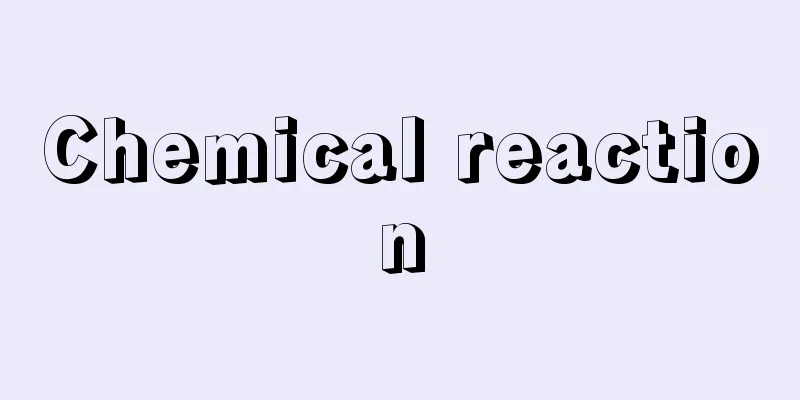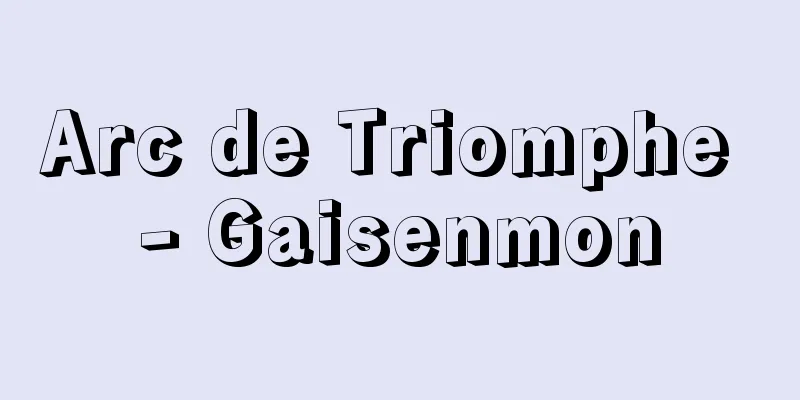Chemical reaction

|
A phenomenon in which a substance changes into another substance by itself or through interaction with other substances. In this case, rearrangements occur between the atoms that make up the substance, but the number of atoms does not change before and after this interaction. It is synonymous with chemical change, but when focusing on the process in particular, it is called a chemical reaction. A chemical reaction equation is used to express this process. Chemical reactions can be classified into various types from various perspectives, such as thermal reactions, photochemical reactions, catalytic reactions, and combustion reactions, or ionic reactions, radical reactions, and nuclear reactions based on the type of reaction, and oxidation-reduction reactions, polycondensation reactions, addition reactions, substitution reactions, chain reactions, and disproportionation reactions based on the reaction mechanism. In organic reactions, they are called hydrogenation reactions, esterification reactions, hydrolysis reactions, etc., depending on the things that participate in the reaction and the type of reaction. [Toda Genjiro and Nakahara Katsunori] Chemical Reactions and Equations The substances involved in the reaction before the change (original substances, reactants) are shown on the left side, and the substances after the change (product substances, products) are shown on the right side as chemical formulas, and the relationship between them is shown by multiplying them by the amount ratio during the reaction (also called the molar ratio, the smallest integer ratio). For example, 2H 2 +O 2 =2H 2 O (1) A chemical reaction reaches equilibrium after a sufficient amount of time has passed. If this equilibrium continues to lean toward either the starting system or the product system, and the reaction only appears to proceed in that direction even if the reaction conditions are changed, this is called an irreversible reaction (equation (2)). If there are equal amounts of both starting and product systems at equilibrium, and the equilibrium shifts if either the starting system or product system is increased, in other words, the reaction can proceed in either direction, this is called a reversible reaction (equation (3)). [Toda Genjiro and Nakahara Katsunori] Reaction Rate and Reaction OrderThe speed at which a reaction moves toward equilibrium is called the reaction rate. This rate is governed by the concentration of the reactants (in the case of gases, this can also be expressed by pressure), the temperature during the reaction, the presence or absence of a catalyst, and other conditions. The dependence of the reaction rate on the concentration of the reactants is expressed as the order of the reaction. When the rate is proportional to the concentration of a substance in the starting system, it is called first order, and when it is proportional to the square of the rate, it is called second order. The sum of the orders for each reactant is called the order of the reaction. Reactions are classified as first order reactions, second order reactions, etc. based on this order. The temperature dependence of the reaction rate constant k , which determines the reaction rate, is expressed by the Arrhenius equation. k = A exp(- E a / RT ) [Toda Genjiro and Nakahara Katsunori] Reaction mechanismThe mechanism by which a chemical reaction occurs is called a reaction mechanism. A reaction mechanism is elucidated by investigating the energy change (e.g., heat of reaction) when a reaction occurs and the parameters that govern the reaction rate. A chemical reaction often consists of several reactions (called elementary reactions) that cannot be divided any further. In other words, a chemical reaction is composed of one or several elementary reactions. When investigating a reaction mechanism, we usually first investigate what elementary reactions the reaction consists of, and then compare the speeds of the elementary reactions. The slowest elementary reaction among the elementary reactions is called the rate-limiting elementary reaction (or rate-limiting reaction or rate-limiting step). When all reactants are in the gas phase, they are called gas-phase reactions, when all reactants are in the liquid phase, they are called liquid-phase reactions, and when all reactants are in the solid phase, they are called solid-phase reactions. All of these cases are homogeneous phase reactions, but when the reactants exist across two phases, they are called heterogeneous reactions (for example, a reaction in a system where a solid catalyst and reactants are gas or liquid is called a heterogeneous catalytic reaction). Reaction rates are treated theoretically in several ways, for example by the collision theory of gas-phase reactions, the transition state method, and absolute reaction rate theory. [Toda Genjiro and Nakahara Katsunori] "Mechanisms of Chemical Reactions" by Nagakura Saburo and Hosoya Haruo (1970, Tokyo Kagaku Dojin) " ▽ "Chemical Reactions and Electron Orbitals" by Fukui Kenichi (1976, Maruzen)" ▽ "How to Make Chemical Reaction Equations" 3rd Edition by Watanabe Yoshikazu (1995, Reimeishobo)" ▽ "How Chemical Reactions Work" by Takeuchi Takahito (2000, Iwanami Shoten) " ▽ "Organic Chemical Reactions" edited by Toshima Naoki et al., written by Matsumoto Masakatsu, Yamada Shinji, and Yokozawa Tsutomu (2005, Asakura Shoten)" [Reference] |Source: Shogakukan Encyclopedia Nipponica About Encyclopedia Nipponica Information | Legend |
|
ある物質がそれ自身で、あるいは他の物質との相互作用によって、他の物質に変わる現象。この場合、物質を構成している原子どうしの間で組み替えがおこるが、原子の数はこの相互作用の前後で変わらない。化学変化と同義語であるが、とくにその過程に注目するときに化学反応という。この過程を表すのに用いるのが化学反応式である。化学反応は種々の見方から、たとえば熱反応、光化学反応、触媒反応、燃焼反応あるいは反応する種類からするイオン反応、ラジカル反応、核反応、また反応機構からする酸化還元反応、重縮合反応、付加反応、置換反応、連鎖反応、不均化反応などとよばれる種類がある。また有機反応では、反応に加わるもの、反応の種類により、水素化反応、エステル化反応、加水分解反応などとよぶ。 [戸田源治郎・中原勝儼] 化学反応式と化学方程式反応に関与する変化前の物質(原系の物質、反応物)を左辺に、変化後の物質(生成系の物質、生成物)を右辺にそれぞれ化学式で表し、反応の際の量比(モル比ともいい、最小整数比)を掛けて相互の関係を示したものである。たとえば 化学反応は、十分に時間が経過したあとでは平衡に達する。この平衡が原系または生成系にずっと傾いているために、反応条件を変えても、見かけ上その方向にしか反応がおこらないものを不可逆反応(式(2))、平衡で原系の物質も生成系の物質もある量ずつ存在し、原系または生成系の物質を増やせば、平衡が移動する、すなわち、どちらの方向へも反応が進むものを可逆反応という(式(3))。 [戸田源治郎・中原勝儼] 反応速度と反応次数平衡に向かう反応の速さを反応速度という。この速度は反応するものの濃度(気体の場合は圧力によっても表される)、反応時の温度、触媒の有無、その他の条件によって支配される。反応速度の反応物濃度への依存は反応次数で表される。速度が原系のある物質の濃度に比例する場合を一次、2乗に比例する場合を二次などという。反応物それぞれについての次数の合計を反応の次数という。この次数により反応を一次反応、二次反応などと区別する。 反応速度を規定する反応速度定数kの温度依存性はアレニウスの式で表される。 k=A exp(-Ea/RT) [戸田源治郎・中原勝儼] 反応機構化学反応のおこる仕組みを反応機構という。反応機構は、反応がおこるときのエネルギー変化(たとえば反応熱)や、反応速度を支配する諸パラメーターを調べることによって解明される。一つの化学反応は、いくつかのそれ以上分けられない反応(素反応という)から成り立つ場合が多い。いいかえれば、化学反応は一つあるいはいくつかの素反応から構成される。反応機構を調べるときには、普通まず反応がどんな素反応から成り立っているかを調べ、そのうえでその素反応のなかでの速さの大小を比べる。素反応のなかでもっとも遅い素反応を律速素反応(または律速反応、律速段階)という。反応するものがすべて気相中にある場合を気相反応、液相にあるものを液相反応、そして固相にあるものを固相反応という。これらの場合はいずれも均一相の反応であるが、反応物が二つの相にまたがって存在する場合を不均一反応という(たとえば、固体の触媒と反応物が気体または液体からなる系の反応は不均一触媒反応という)。反応速度は理論的にいくつかの方法、たとえば、気相反応の衝突説、遷移状態法、絶対反応速度論などによって取り扱われる。 [戸田源治郎・中原勝儼] 『長倉三郎・細矢治夫著『化学反応の機構』(1970・東京化学同人)』▽『福井謙一著『化学反応と電子の軌道』(1976・丸善)』▽『渡辺義一著『化学反応式の作り方』3訂版(1995・黎明書房)』▽『竹内敬人著『化学反応のしくみ』(2000・岩波書店)』▽『戸嶋直樹他編、松本正勝・山田眞二・横澤勉著『有機化学反応』(2005・朝倉書店)』 [参照項目] |出典 小学館 日本大百科全書(ニッポニカ)日本大百科全書(ニッポニカ)について 情報 | 凡例 |
<<: Price display - Price display
Recommend
Kusazuribiki - Kusazuribiki
A common name for a style of Kabuki performance, ...
Esquirol, Jean-Étienne-Dominique
Born: February 3, 1772 in Toulouse Died December 1...
Tochigami (English spelling) Earth god
The god of the earth and the guardian deity of vil...
Filippo Buonarroti
An Italian international revolutionary. Born into...
Line
〘noun〙① Thread. Something that is thin and long li...
Wassily Kandinsky
A Russian-born French painter, he is considered t...
Witherspoon, J.
…The term was first used by John Witherspoon in 1...
Lounge suit
… The origins of the suit are said to date back t...
External photon effect
…(1) Photon (quantum) effect type This type utili...
Zimri-Lim (English spelling) ZimriLim
...Mari, located in the middle reaches of the Eup...
Hosoi Wakizo
A proletarian writer from the Taisho period. Born...
Egnashvili, B.
…Tiflis (now Tbilisi) had a population of 25,000 ...
Gaslight paper
... The emulsion used is a silver halide gelatin ...
Song Book - Utanohon (English) Buch der Lieder
This is a collection of poems written in the yout...
Volcanic ash - kazanbai
Fine volcanic debris with a diameter of 2 mm or l...





![Mitoya [town] - Mitoya](/upload/images/67ccf3570b27d.webp)

![Kanegasaki [town] - Kanegasaki](/upload/images/67cb3b2f6f1f6.webp)

